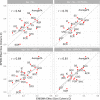Integration of routine QA data into mega-analysis may improve quality and sensitivity of multisite diffusion tensor imaging studies
- PMID: 29181875
- PMCID: PMC5764798
- DOI: 10.1002/hbm.23900
Integration of routine QA data into mega-analysis may improve quality and sensitivity of multisite diffusion tensor imaging studies
Abstract
A novel mega-analytical approach that reduced methodological variance was evaluated using a multisite diffusion tensor imaging (DTI) fractional anisotropy (FA) data by comparing white matter integrity in people with schizophrenia to controls. Methodological variance was reduced through regression of variance captured from quality assurance (QA) and by using Marchenko-Pastur Principal Component Analysis (MP-PCA) denoising. N = 192 (119 patients/73 controls) data sets were collected at three sites equipped with 3T MRI systems: GE MR750, GE HDx, and Siemens Trio. DTI protocol included five b = 0 and 60 diffusion-sensitized gradient directions (b = 1,000 s/mm2 ). In-house DTI QA protocol data was acquired weekly using a uniform phantom; factor analysis was used to distil into two orthogonal QA factors related to: SNR and FA. They were used as site-specific covariates to perform mega-analytic data aggregation. The effect size of patient-control differences was compared to these reported by the enhancing neuro imaging genetics meta-analysis (ENIGMA) consortium before and after regressing QA variance. Impact of MP-PCA filtering was evaluated likewise. QA-factors explained ∼3-4% variance in the whole-brain average FA values per site. Regression of QA factors improved the effect size of schizophrenia on whole brain average FA values-from Cohen's d = .53 to .57-and improved the agreement between the regional pattern of FA differences observed in this study versus ENIGMA from r = .54 to .70. Application of MP-PCA-denoising further improved the agreement to r = .81. Regression of methodological variances captured by routine QA and advanced denoising that led to a better agreement with a large mega-analytic study.
Keywords: DTI; QA; mega-analysis; multi-site research; schizophrenia.
© 2017 Wiley Periodicals, Inc.
Figures


Similar articles
-
The Marburg-Münster Affective Disorders Cohort Study (MACS): A quality assurance protocol for MR neuroimaging data.Neuroimage. 2018 May 15;172:450-460. doi: 10.1016/j.neuroimage.2018.01.079. Epub 2018 Feb 1. Neuroimage. 2018. PMID: 29410079
-
Heterochronicity of white matter development and aging explains regional patient control differences in schizophrenia.Hum Brain Mapp. 2016 Dec;37(12):4673-4688. doi: 10.1002/hbm.23336. Epub 2016 Aug 1. Hum Brain Mapp. 2016. PMID: 27477775 Free PMC article.
-
The impact of quality assurance assessment on diffusion tensor imaging outcomes in a large-scale population-based cohort.Neuroimage. 2016 Jan 15;125:903-919. doi: 10.1016/j.neuroimage.2015.10.068. Epub 2015 Oct 28. Neuroimage. 2016. PMID: 26520775 Free PMC article.
-
Neuroimaging studies within Cognitive Genetics Collaborative Research Organization aiming to replicate and extend works of ENIGMA.Hum Brain Mapp. 2022 Jan;43(1):182-193. doi: 10.1002/hbm.25040. Epub 2020 Jun 5. Hum Brain Mapp. 2022. PMID: 32501580 Free PMC article. Review.
-
The role of diffusion tensor imaging and fractional anisotropy in the evaluation of patients with idiopathic normal pressure hydrocephalus: a literature review.Neurosurg Focus. 2016 Sep;41(3):E12. doi: 10.3171/2016.6.FOCUS16192. Neurosurg Focus. 2016. PMID: 27581308 Review.
Cited by
-
Comparison of heritability estimates on resting state fMRI connectivity phenotypes using the ENIGMA analysis pipeline.Hum Brain Mapp. 2018 Dec;39(12):4893-4902. doi: 10.1002/hbm.24331. Epub 2018 Jul 27. Hum Brain Mapp. 2018. PMID: 30052318 Free PMC article.
-
Statistical harmonization corrects site effects in functional connectivity measurements from multi-site fMRI data.Hum Brain Mapp. 2018 Nov;39(11):4213-4227. doi: 10.1002/hbm.24241. Epub 2018 Jul 1. Hum Brain Mapp. 2018. PMID: 29962049 Free PMC article.
-
Replication and generalization in applied neuroimaging.Neuroimage. 2019 Nov 15;202:116048. doi: 10.1016/j.neuroimage.2019.116048. Epub 2019 Jul 26. Neuroimage. 2019. PMID: 31356879 Free PMC article.
-
Social Cognitive Networks and Social Cognitive Performance Across Individuals With Schizophrenia Spectrum Disorders and Healthy Control Participants.Biol Psychiatry Cogn Neurosci Neuroimaging. 2021 Dec;6(12):1202-1214. doi: 10.1016/j.bpsc.2020.11.014. Epub 2020 Dec 5. Biol Psychiatry Cogn Neurosci Neuroimaging. 2021. PMID: 33579663 Free PMC article.
-
Diffusion MRI Indices and Their Relation to Cognitive Impairment in Brain Aging: The Updated Multi-protocol Approach in ADNI3.Front Neuroinform. 2019 Feb 19;13:2. doi: 10.3389/fninf.2019.00002. eCollection 2019. Front Neuroinform. 2019. PMID: 30837858 Free PMC article.
References
-
- Ellison‐Wright, I. , & Bullmore, E. (2009). Meta‐analysis of diffusion tensor imaging studies in schizophrenia. Schizophrenia Research, 108(1–3), 3–10. - PubMed
-
- Friedman, J. I. , Tang, C. , Carpenter, D. , Buchsbaum, M. , Schmeidler, J. , Flanagan, L. , … Davis, K. L. (2008). Diffusion tensor imaging findings in first‐episode and chronic schizophrenia patients. The American Journal of Psychiatry, 165(8), 1024–1032. - PubMed
Publication types
MeSH terms
Grants and funding
LinkOut - more resources
Full Text Sources
Other Literature Sources
Miscellaneous

